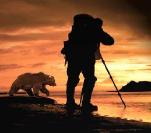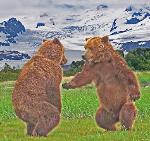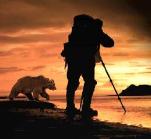Ice Age Cook Inlet
| Glacial Ice Shelves & Icebergs |




As shown on the previous page, if a glacier retreats, a lake can form between it and one or more of its end moraines. If the glacier later
advances again, it can push out into that lake. If the lake is shallow, the water is simply pushed aside or flows through a break in the end
moraine. However, if the lake is deep, the foot of the glacier might float on the water. As the floating portion extends ever farther into the lake,
and the plastic bottom ice melts away in the water, the foot becomes increasingly likely to break free (i.e., calve) and float away in the lake,
whereupon it is known as an ice berg. Erosion of an ice shelf is quickest if the water is relative warm and/or salty (i.e,. oceanic), and if there is
heavy wave action against the cliff face, and/or large variation in tidal level, such that the base of the cliff becomes strongly undercut, as
shown in the large ice berg below.
advances again, it can push out into that lake. If the lake is shallow, the water is simply pushed aside or flows through a break in the end
moraine. However, if the lake is deep, the foot of the glacier might float on the water. As the floating portion extends ever farther into the lake,
and the plastic bottom ice melts away in the water, the foot becomes increasingly likely to break free (i.e., calve) and float away in the lake,
whereupon it is known as an ice berg. Erosion of an ice shelf is quickest if the water is relative warm and/or salty (i.e,. oceanic), and if there is
heavy wave action against the cliff face, and/or large variation in tidal level, such that the base of the cliff becomes strongly undercut, as
shown in the large ice berg below.



the ablation zone of a glacier, and then go on to
melt surface ice quite unevenly, producing a rough
icescape of hummocks and turquoise ponds. In
some cases these ponds are deep enough to form
a lake. Or, if there is a crack in the ice, water can
pour down it into the interior of the glacier and out
the bottom. At right is a sink hole draining the
surface of a glacier. Water flowing out of a glacier
can melt caves -- which can be quite beautiful. But
they are also treacherous.
melt surface ice quite unevenly, producing a rough
icescape of hummocks and turquoise ponds. In
some cases these ponds are deep enough to form
a lake. Or, if there is a crack in the ice, water can
pour down it into the interior of the glacier and out
the bottom. At right is a sink hole draining the
surface of a glacier. Water flowing out of a glacier
can melt caves -- which can be quite beautiful. But
they are also treacherous.
A shift in the glacier can suddenly cause a cave to collapse or a surface lake to
drain, producing an internal flash flood that could drown anyone inside the cave.
Some ice caves persist even after a section of the glacier has calved off as an ice
berg, as shown at left.
drain, producing an internal flash flood that could drown anyone inside the cave.
Some ice caves persist even after a section of the glacier has calved off as an ice
berg, as shown at left.




The pressure of the glacier against the rock is so high that it melts
by shifting the mass of the glacier up or sideways, but by melting.
the surface of the ice. The water flows around the obstruction, then
refreezes on the downhill side. That's how the glacier at left was
able to squeeze through the bottleneck of bedrock headlands
by shifting the mass of the glacier up or sideways, but by melting.
the surface of the ice. The water flows around the obstruction, then
refreezes on the downhill side. That's how the glacier at left was
able to squeeze through the bottleneck of bedrock headlands
| Bear Viewing Association To watch, to wonder, and to conserve [email protected] Ph/Fax (907) 260-9059 (Office) 39200 Alma Ave. Soldotna, AK 99669 |


| Bear Viewing Association To watch, to wonder, and to conserve [email protected] Ph/Fax (907) 260-9059 (Office) 39200 Alma Ave. Soldotna, AK 99669 |


| Glaciers, Glacial Landscapes, and Their Roles in the Ecology of Alaskan Bears |